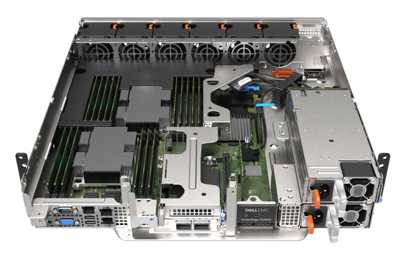Dell EMC: Bare Metal Making Comeback
Key advantage is that it allows applications to access hardware resources directly, whether in form of CPU, DDR4 RAM, NVMe, GPU, FPGA, or SmartNICs.
This is a Press Release edited by StorageNewsletter.com on October 15, 2020 at 2:26 pm![]() This blog was written by Hemant Rawat, product manager, telco service providers, on a blog of Dell Technologies, Inc.
This blog was written by Hemant Rawat, product manager, telco service providers, on a blog of Dell Technologies, Inc.
From DCOps to DevOps
IT began its journey with mainframes. Then came the x86 revolution. x86 ruled the world by providing a platform to run applications and databases. Next came the age of virtualization, which shifted the focus from hardware to a software-defined infrastructure that allowed IT workers to run multiple applications on a single server with simple portability between servers.
As the business landscape continues to evolve, there is a new wave of ‘as-a-service’ solutions to address everything from infrastructure (IaaS) to platforms (PaaS) to all manner of software applications (SaaS). It is clear that ‘as-a-service’ is going to be here for a long time, as it provides greater flexibility in terms of commercial models (e.g., OpEx over CapEx, subscription-based) and operational agility (e.g., on-demand, self-serve, API-driven, automation).
Bare metal, though a foundational element for all the XaaS solutions, was buried under abstractions. Today, we see a revived interest in bare metal across industries; and for some, bare metal is a fundamental substrate in the legacy IaaS definition that, when isolated, brings benefits to enterprise customers.
What is bare metal, and why is it regaining its lost glory?
Bare metal is a physical server with no software/hypervisor – just processors, memory, NICs, and storage. A key advantage is that it allows applications to access hardware resources directly, whether in the form of CPU, DDR4 RAM, NVMe, GPU, FPGA, or SmartNICs.
So, what’s driving the revival in bare metal demand?
-
Resource intensive workloads
Applications and databases are demanding more compute, memory, and storage resources. Use cases like gaming, video transcoding, and augmented/virtual reality applications require predictable performance. Latency-sensitive applications such as autonomous vehicles and telco workloads will need access to physical NICs to offload data plane processing.
-
The rise of AI/ML
Enterprises have started embedding AI/ML in their business processes. These are compute-intensive processes that require additional resources in the form of GPUs for accelerated training and inferencing.
-
The maturity of the cloud-native
As more and more workloads are created with a microservices-based architecture, technologies such as containers and their orchestration have matured. Containers on bare metal are gaining momentum, as they provide lower latency for memory access and better CPU-utilization metrics. Other initiatives like Metal operator, MetalLB, and Metal3 are also making it easier to run containers on bare metal.
-
Security and compliance
With control and access to the hardware components, bare metal lets you choose how a server is being used and who has access to it, ensuring data protection for sensitive applications.
-
Real-time analytics
Many enterprises are looking for hyper-customized, in-memory data processing to leverage real-time analytics on their streaming data. Bare metal offers performance with access to NVMe, DDR4 RAM, and other accelerators, providing millions of IO/s.
Bare metal provisioning is a complex task that involves multiple tools and time-consuming processes. But what if the same bare metal is made available in the cloud, where it can be consumed in mere minutes? This new approach of bare metal as a service would allow users to have full access to the servers with cloud-based automation so that users can focus on their applications without having to worry about underlying server provisioning and hardware maintenance.
Dell has partnered with Equinix, Inc. to provide Equinix Metal to provide a bare-metal-as-a-sService solution. It offers the same user experience as Dell bare metal servers but in a service-based consumption model. In this model, Equinix manages the server procurement, installation, and hardware lifecycle, while customers still enjoy complete server access with the full advantages of automation, thus accelerating innovation.
BMaaS solution layers
-
Hardware layer. This layer is powered by the PowerEdge series of servers. Users can access these servers through API, CLI, SDK, or UI without maintaining their own data centers.
-
Southbound abstraction layer. This layer is responsible for bootstrapping the bare metal server, power management, and firmware management – all without any human interactions. This layer is also being made open source for community participation.
-
Cloud API layer. This layer provides user access to bare metal servers. It allows on-demand consumption of servers, self-serve portal, API access, and billing management. It facilitates programmatic interaction with all aspects of the server – including cloud-init and metadata – using conventional HTTP requests. Native API libraries in popular languages (Golang, Ruby, Python, Java, PHP) are also available.
The entire solution has been designed with DevOps principles in mind, where the full server can be consumed as a piece of software. Users can leverage tools like Terraform and Ansible and integrate the server deployment in their CI/CD pipeline.
What does BMaaS do for your business?
This new operating model is aimed at:
-
Eliminating Capex outflow
-
Achieving predictable Opex
-
Accelerating application deployment
-
Making a business more agile
-
Allowing hybrid-cloud strategy
-
Simplifying infrastructure management
-
Promoting cloud-native development with APIs and DevOps tooling support for bare metal
-
Serving high performance compute services to all bare metal hungry workloads
Choosing the right compute platform is critical for success. Doing it the right way can move your business priority shift from data center operations to DevOps, where you manage the apps, and we manage the ops. Lastly, bare metal is the catalyst for the anticipated promise of a true multi and hybrid cloud platform.

















 Subscribe to our free daily newsletter
Subscribe to our free daily newsletter

